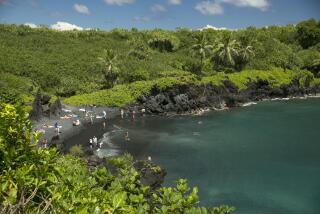Avalon May Tax Business to Promote Tourism : Chamber of Commerce Says $157,000 Is Needed for Advertising on Mainland
- Share via
AVALON — Funding for an off-season advertising campaign by the Catalina Chamber of Commerce may come from businesses that would benefit from more visitors, rather than from tourists as originally proposed.
Under a new plan discussed by the City Council this week, the city would create a Parking and Business Improvement Area and assess all businesses a percentage of their gross revenues to raise the $157,000 the chamber says it needs to pay for media kits and billboard, magazine and newspaper advertising on the mainland during the fall and winter, referred to as the island’s “undiscovered season.”
When the advertising proposal was first presented to the City Council in March, the chamber had proposed raising the money by increasing wharfage fees, a 60-cent levy on passengers arriving and departing on commercial carriers, and raising transient taxes, a 7% levy on hotel rooms.
There had been opposition to raising the wharfage fee because some officials said that visitors were already overtaxed and that the increases could discourage visitors.
Gann Initiative
Also, the transient tax is limited by the 1980 Gann initiative, which limits general fund expenditures for California cities to 1978 levels, adjusted only according to a city’s population growth and the consumer price index.
City Manager John Longley said the $157,000 raised by transient taxes would exceed the Gann limit by $148,675.41. However, any money raised through assessments under the Parking and Business Improvement Act of 1979 would not fall under Gann limits.
The Business Improvement Act, which has been used primarily to create parking lots, also allows assessments for the general promotion of business in an area. However, if a majority of the affected businesses oppose the plan, the assessment district could not be established.
The City Council will hold a public hearing on the matter June 17.
A four-member committee--two each from the City Council and chamber--was formed to work out details of the plan. Councilman W. F. (Oley) Olsen said the plan could include three levels so businesses benefitting most by more visitors, such as hotels, would pay more than those whose benefit would be indirect, such as a grocery stores and laundries.
If each of the 250 businesses that have business licenses was to pay an equal share, each would pay about 0.325% of its gross income, Olsen said.
A random survey of businesses indicated mixed feelings about the new tax.
Al Solomon, who owns El Encanto Market Place and the popular Solomon’s Landing restaurant and bar, said he is opposed to government getting involved with business.
“I’m totally against that sort of thing,” he said. “I’m a strong believer in the free enterprise system and I don’t think the city should be involved. It’s the easy way out. If the chamber wants the money, let them raise it themselves.”
Richard Slattery, whose wife, Helene, owns the Boots and Straps, a women’s clothing store, said he, too, is opposed to the proposal.
“I just don’t see how it is going to be beneficial to a business like ours,” he said. “I don’t see how advertising is going to bring in more people.”
Thomas Cappanelli, who owns the Villa Portofino hotel and restaurant, said, “I think it’s a good idea. A business has to invest a little money to make some money.”
“Each and every resident is supported by the visitors, either through actual income or through services, which are highly subsidized,” said City Manager Longley in defending the city’s role in the plan. The city already provides the chamber with $60,000 a year for promotion. “It behooves all of us, then, to support reasonable efforts to encourage tourism, especially during the ‘undiscovered season,’ ” Longley said.
Chamber executive director Ken Weiss said only a minority of businesses are opposed to the plan and he is confident that the proposal will be approved by chamber members.
In the last five years, Santa Catalina Island visitors dropped from about 1 million annually to about 700,000, chamber officials said, with only about 10% of those visiting in the off-season.
More to Read
Sign up for Essential California
The most important California stories and recommendations in your inbox every morning.
You may occasionally receive promotional content from the Los Angeles Times.










